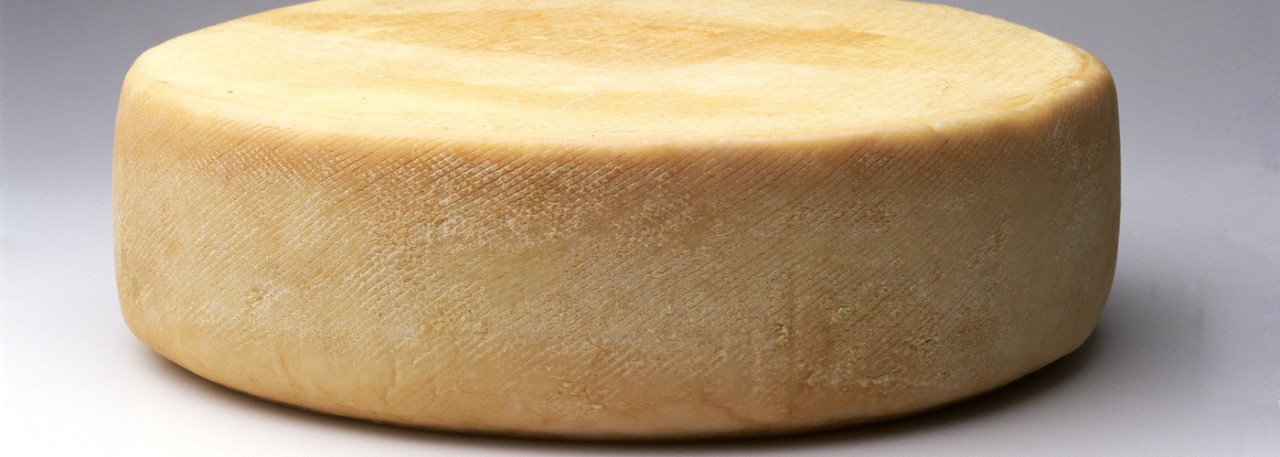.png.transform/rendition-xs/image_image%20(1).png)
Queso Palmero PDO
Pressed cheese made on the island of La Palma in the Canaries, using whole, raw milk from goats of the Palmera breed.
Tasting notes
A clean flavor and aroma of goat’s milk and natural rennet. Reminiscent of grass, hay, mushrooms or nuts. The smoked cheeses offer aromas of almond shell, Canary pine needles and dry prickly pears. Slightly sharp on the palate with medium saltiness, and some sweet notes in the aftertaste. The texture is firm, elastic and medium soft.
Other notes
A flattened cylindrical shape with flat top and bottom. Height 6-15 cm (2½-6”), diameter 12-60 cm (4¾--23½”) (two to four times the height) and weight 0.75-16 kg (1½ -33 lb).The rind on the sides is smooth, and may have small round marks from the holes made in the molds to drain off the whey. The top and bottom may have small, square markings.
The color is white in unsmoked cheeses and may become yellowish during ripening. Smoked cheeses may be brownish and have darkish stripes. When the cheeses have been rubbed with oil, cornmeal or flour, the rind is colored accordingly. The producer’s identification seal is imprinted on the top.
The paste is a shiny white, turning ivory or matt with ripening. The cut surface shows no cavities or cracks, although there may be some small, unevenly distributed eyes. The physical and chemical characteristics vary depending on the degree of ripening but minimum contents are as follows:
-Protein: 17.5%
-Fat in dry matter: 35.10%
-Dry matter: 48.5%.
Production / Processing method
The goats feed on natural pastures. The Palmera goat offers a high milk yield and the milk is very appropriate for cheese-making, because of its high levels of the alpha-casein milk protein.
The milk used must be the whole, natural product of healthy goats belonging to dairy farms registered with the Regulatory Council. It must be clean and contain no colostrum, medications, preservatives, etc. which might negatively affect the production, ripening and storage of the cheese as well as its health and hygiene conditions.
The goats are carefully milked manually or by machine in hygienic conditions to hold back microbe development. After filtering, the milk is coagulated by adding natural rennet taken from the dried stomachs of kids, or using other starters authorized by the Regulatory Council. For the coagulation process, the milk must be kept at 27-33ºC (80-91ºF) for approximately 45 minutes.
The resulting curds are cut to the size of small grains then transferred to ring-shaped molds where they are pressed and placed on plastic, square-meshed sheets to drain.
The cheeses are then salted, usually using dry, sea salt from the island’s salt pans. If salting is by immersion, the brine must be at a maximum concentration of 20º Beaumé, and immersion must last no more than 24 hours.
After salting, the cheeses are often smoked, using smoke from different sources – usually almond shells (Prunus dulcis), prickly pears (Opuntia ficus indica) or Canary pine (Pinus canariensis).
Ripening is carried out in caves or special storage facilities. During the process, the cheeses are turned regularly and may be rubbed with olive oil, cornmeal or flour to protect them.
Geography / Relief and climate
The island of La Palma, a World Biosphere Reserve, is located at the north-western tip of the Canary archipielago. It has a total surface area of 706 km2 (273 sq miles) and is the world’s most mountainous island in proportion to its size. Maximum distances are 45 km (28 miles) between the Punta de Juan Adalid and Fuencaliente lighthouse, and 28 km (17½ miles) between Puntallana and Puntagorda. The island’s irregular relief means that it has very varied microclimates, allowing cattle to forage all year round.
In general, the climate is very temperate below an altitude of 500 m (1,640 ft), and more continental towards 1,500 m (4,921 ft). At the Roque de los Muchachos at 2,426 m (7,959 ft), it is harsh, with icicles often forming over holes formed by the strata of lava and pyroclasts, and there may be snow and freezing blizzards.
The island is very wet with frequent rainfall in winter caused by depressions over the Atlantic and by the condensation of moisture brought by the trade winds. The result is green ground cover all year round.
The vegetation is rich and varied, with endemic species and high-quality pastures. The main forage plant is tagasaste (Chamaecytisus proliferus), an endemic plant on La Palma.
Regulatory Council
Consejo Regulador de la DOP Queso Palmero
C/ Europa, 6
38710 Breña Alta, Isla de La Palma
Canarias
Tel: (+34) 922 417 060
quesopalmero@quesopalmero.es
www.quesopalmero.es
Sources:
- Spanish Ministry of Agriculture
The color is white in unsmoked cheeses and may become yellowish during ripening. Smoked cheeses may be brownish and have darkish stripes. When the cheeses have been rubbed with oil, cornmeal or flour, the rind is colored accordingly.


- Palmero 1
- Palmero 2

Breña Alta (Canary Islands)
